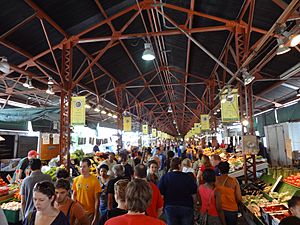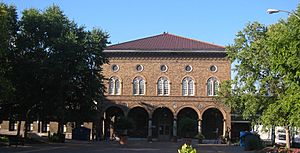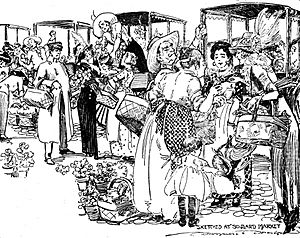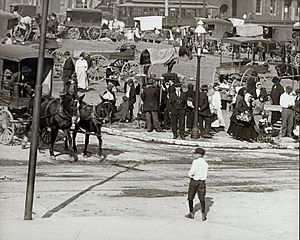Soulard Farmers Market facts for kids
The Soulard Farmers Market is a very old public market in St. Louis, Missouri. It is located in the Soulard neighborhood. This market is special because it is the only one in St. Louis run by the city. Many people say it is the oldest public market west of the Mississippi River in the United States.
Contents
Market History
How the Market Started
The market began in 1779 in a flat, open field. Farmers would come there to sell their fresh goods. It was the third public market ever in St. Louis.
A man named Antoine Soulard was important to the market's history. He was born in France in 1766. Antoine was a former French military officer. He came to America to escape problems from the French Revolution.
In 1795, Antoine married Julia Cerré. Her father, Gabriel Cerré, had received the land where the market was located from Spain in 1782. Gabriel Cerré gave Antoine Soulard a large piece of land, about 122 acres. This land included the market area.
Land Ownership and Donation
In 1803, the Louisiana Purchase happened. This led to a big legal fight over who owned the land. The fight lasted for many years.
Antoine Soulard died in 1825. Finally, in 1836, his wife Julia Cerré Soulard officially gained ownership of the land. In 1835, her land was divided into smaller plots. It also became part of the city of St. Louis.
Between 1841 and 1842, Julia Soulard gave two city blocks to St. Louis. This land was to be used for the farmers market. It became known as Soulard Market. She had one important rule: it had to stay a public marketplace forever. Julia Soulard passed away in 1845. By 1854, the city fully owned the market property.
Early Market Buildings
Before any buildings were put up, local farmers would set up their horses and wagons in a circle. They sold their goods right from their wagons. Some farmers would arrive as early as 3 AM. Customers would start coming around 6 AM. By 10 AM, the market would be very busy and full of people.
In the late 1830s and 1840s, a main market building was constructed. Other smaller buildings were also built. During the American Civil War, the market area was used as a camp for the Union Army.
These first buildings were badly damaged by a strong storm. This storm was the 1896 St. Louis–East St. Louis tornado. The tornado blew off the market's roof. A large part of the building was destroyed. Sadly, nine people were found dead in the rubble.
The New Grand Hall
In 1929, a new building was built to replace the damaged one. This new building was designed in a Renaissance style. It looked like the Foundling Hospital in Florence, Italy. That hospital was designed by Filippo Brunelleschi in 1419.
The new main building is called the Grand Hall. It is shaped like the letter 'H' and has four wings. Albert E. Osberg designed this building. The first floor of the Grand Hall has shops. The second floor used to have a gym and a theater. The four wings of the building are filled with vendor stalls.
Soulard Market Today
The Soulard Farmers Market is open from Wednesday through Saturday all year long. Saturdays are the busiest days at the market. There are more than 140 vendors selling their products.
The shops inside the Grand Hall are permanent stores. You can find bakeries, butcher shops, florists, and a spice shop there. The vendors outside sell many different things. These include fresh fruits and vegetables, fish, cheese, soap, and handmade crafts. Many vendors are part of families who have had their stalls for generations.
Near the market, you can find parking. There is also a playground, a park, and a plaza. On Saturday mornings, a local chef often cooks a dish. They use fresh items bought right from the market. Many vendors only come to the market on Saturdays.





